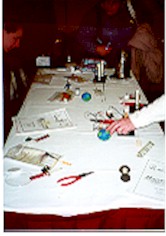


48TH ANNUAL MSTA Conference
MARCH 9TH-10TH, 2001
By Brian Purcell, Physics Teacher, Dearborn Public Schools



GETTING ATTACHED TO MAGNETISM
Mike McCullum and Arlene Hicks
Subject Areas : Physics
Their handout emphasized one of the key points in science; namely misconceptions. For example, they noted that students sometimes think that all metals are attracted to magnets, or that only shiny ones are. A nice tip is to have a prior writing assignment for the introduction of new subjects so as to identify these misconceptions. This may help guide the lesson.
Their first exercise explored the idea of the magnetic properties of various materials. We used a handful of small disks that the teacher made – wood, plastic, iron filings glued on poster board, and the like and tested each with two small inexpensive magnets.
To introduce the next experiment, he asked a question extending from our conclusive observations about the disks. Do magnets only attract ? So now we used the two magnets and tried to find out their behavior together and we were asked to craft it into a statement.
In still another activity, we looked at magnetic field lines with a compass as well as iron filings. Included in our kit were the parts for a magnetic motor using a wire, magnet, paper clips, and a battery too. In still another, we induced a magnetic field in a coat hanger.
Mr. McCullum balanced a folded dollar bill on a toothpick and moved it with a magnet. Finally, analogies help too. Using a laser with a diffraction grating and a piece of string marked off at the half-way point, one can show the inverse square law relation for light for when they are describing it in magnetism. Mark on the chalkboard the pattern generated at the strings half-way point with the string perpendicular to the board. Next move it the full distance and again draw the pattern and compare. It is roughly the desired outcome of 4 times larger in area.
Finally, no discussion about magnetism is complete without its connection to electricity. Besides the electric motor in our kit, we were shown a film tube with the bottom cut off and wire wrapped around it. The wires were then attached to a phone jack and these wires went to a compass with the exposed wires wrapped around the compass. Passing a magnet through the tube induced a current in the wire and then the wire with its current generated a magnetic field that affected the compass.
Most of these items were common and often found at dollar stores and one could also find this information for these activities at their Web site as well – MAP ScienceScene.com.